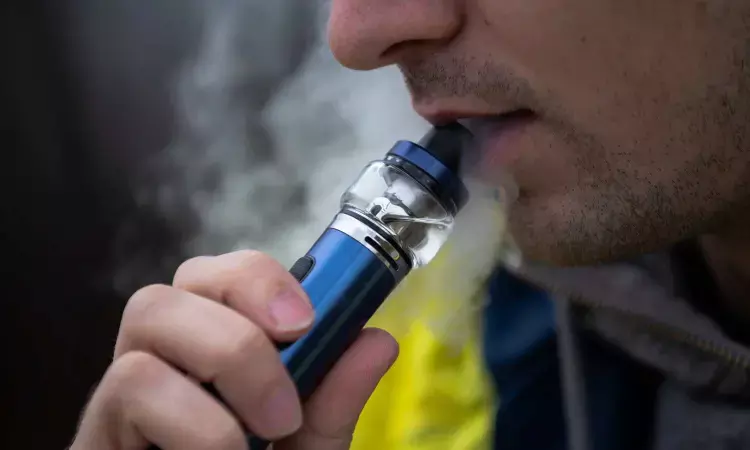- Home
- Medical news & Guidelines
- Anesthesiology
- Cardiology and CTVS
- Critical Care
- Dentistry
- Dermatology
- Diabetes and Endocrinology
- ENT
- Gastroenterology
- Medicine
- Nephrology
- Neurology
- Obstretics-Gynaecology
- Oncology
- Ophthalmology
- Orthopaedics
- Pediatrics-Neonatology
- Psychiatry
- Pulmonology
- Radiology
- Surgery
- Urology
- Laboratory Medicine
- Diet
- Nursing
- Paramedical
- Physiotherapy
- Health news
- Fact Check
- Bone Health Fact Check
- Brain Health Fact Check
- Cancer Related Fact Check
- Child Care Fact Check
- Dental and oral health fact check
- Diabetes and metabolic health fact check
- Diet and Nutrition Fact Check
- Eye and ENT Care Fact Check
- Fitness fact check
- Gut health fact check
- Heart health fact check
- Kidney health fact check
- Medical education fact check
- Men's health fact check
- Respiratory fact check
- Skin and hair care fact check
- Vaccine and Immunization fact check
- Women's health fact check
- AYUSH
- State News
- Andaman and Nicobar Islands
- Andhra Pradesh
- Arunachal Pradesh
- Assam
- Bihar
- Chandigarh
- Chattisgarh
- Dadra and Nagar Haveli
- Daman and Diu
- Delhi
- Goa
- Gujarat
- Haryana
- Himachal Pradesh
- Jammu & Kashmir
- Jharkhand
- Karnataka
- Kerala
- Ladakh
- Lakshadweep
- Madhya Pradesh
- Maharashtra
- Manipur
- Meghalaya
- Mizoram
- Nagaland
- Odisha
- Puducherry
- Punjab
- Rajasthan
- Sikkim
- Tamil Nadu
- Telangana
- Tripura
- Uttar Pradesh
- Uttrakhand
- West Bengal
- Medical Education
- Industry
Vaping increases asthma risk among adolescents, study suggests

USA: A recent study has revealed a potential relationship between the use of e-cigarettes (vaping) and asthma among US adolescents.
The findings, published in the journal Preventive Medicine, highlight the need for public health strategies to tackle the increasing prevalence of e-cigarette use and its adverse health effects.
"Vaping increases the risk of asthma in adolescents who have never smoked conventional tobacco products," the researchers stated.
Vaping, or the use of electronic cigarettes (e-cigarettes), among adolescents has grown dramatically over the past several years. Although e-cigarettes have fewer toxins than regular cigarettes, they still contain a mixture of harmful chemicals and raise the risk of respiratory diseases.
In this new study, which was published in Preventive Medicine, researchers analyzed data from a national survey of youth to determine whether there is an association between vaping and asthma. The researchers also sought to identify factors that may be associated with e-cigarette use in adolescents.
The team used data from the Youth Risk Behavior Surveillance System, a national health dataset set up by the Centers for Disease Control and Prevention to track the health behaviors and outcomes of children and youth. This study used data collected between 2015 and 2019 that included information on e-cigarette use. The analysis included data on more than 3,000 adolescents aged 13 to 17 in Texas and more than 32,000 adolescents in the United States for comparison.
The survey asked respondents whether they had ever used an e-cigarette, how many days during the previous 30-day period they had used one, and whether they had ever been told they had asthma by a health care professional. The study included information on respondent gender, age, race and ethnicity, body mass index (BMI) and presence of depression symptoms. The analysis also included data on the use of other substances, such as conventional cigarettes, alcohol and illicit drugs.
The study identified an association between e-cigarette use and asthma in adolescents who had never smoked conventional tobacco products. This demonstrates that vaping increases the risk of asthma independently from conventional tobacco product use in adolescents.
Risk Factors
The researchers also found evidence that some demographic factors, behaviours related to substance use, and the presence of depressive symptoms are associated with e-cigarette use. Adolescents who used conventional cigarettes, alcohol and other substances were more likely to use e-cigarettes, as were subjects with depression.
Additionally, Hispanic adolescents in Texas were significantly less likely to have used e-cigarettes than their non-Hispanic White peers. However, the researchers found no notable differences between racial and ethnic groups in the U.S. overall. More research is needed to identify factors that could be associated with lower e-cigarette use among Hispanic adolescents in Texas.
“Increasing knowledge about the harmful effects of e-cigarette use, implementing stricter regulations, and promoting alternative coping mechanisms for mental health are potential interventions to mitigate e-cigarette use,” said Dr. Taehyun Roh, lead author of the study.
Given the burdens presented by asthma and the growing use of e-cigarettes in adolescents, the researchers are hopeful that these findings will help inform public health efforts to reduce e-cigarette use.
Reference:
Taehyun Roh, Kido Uyamasi, Anisha Aggarwal, Alexander Obeng, Genny Carrillo, Association between e-cigarette use and asthma among US adolescents: Youth Risk Behavior Surveillance System 2015–2019, Preventive Medicine,https://doi.org/10.1016/j.ypmed.2023.107695.
Dr Kamal Kant Kohli-MBBS, DTCD- a chest specialist with more than 30 years of practice and a flair for writing clinical articles, Dr Kamal Kant Kohli joined Medical Dialogues as a Chief Editor of Medical News. Besides writing articles, as an editor, he proofreads and verifies all the medical content published on Medical Dialogues including those coming from journals, studies,medical conferences,guidelines etc. Email: drkohli@medicaldialogues.in. Contact no. 011-43720751


